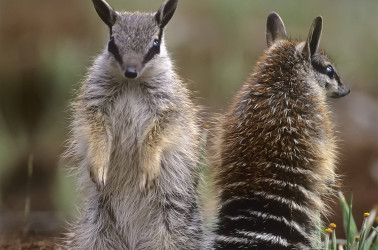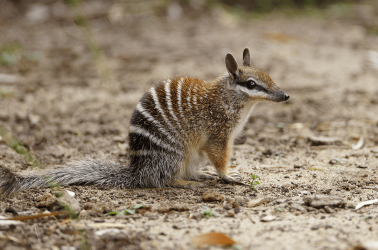Weighing less than a kilogram and featuring a pointed muzzle and sticky tongue, Numbats are capable of vacuuming up 20,000 termites a day. Once widespread across southern Australia, the species remains in several small colonies in Western Australia.
PROJECT EXTENSION: Protecting and understanding Numbats
to ensure their survival
The Project
To protect and grow populations of endangered species, we need to understand their behaviour, life cycles and threats. For the Numbats in Western Australia's Dryandra Woodlands National Park, this means the continuation of our radio-collar program with Numbat Task Force, which has fed vital information back to researchers about what is endangering these native marsupials.
Why we need to act
Known as the Noombat in the Nyungar language, and Walpurti in the Pitjantjatjara dialect. They are one of only two diurnal marsupials – active during the day rather than night – making them a special addition to Australia’s incredible biodiversity. While sitting in the same order as other carnivorous marsupials, numbats are only distantly related to animals like quolls and the Tasmanian Devil, and are actually more closely aligned with the extinct Thylacine.
Numbats are the sole member of their family, Myrmecobiidae, which studies suggest puts their impact on phylogenetic diversity loss as far greater should they go extinct – just one more reason they need to be saved.

Threats to the species
Numbats are one of Australia’s most threatened marsupials, being listed under the EPBC Act and the IUCN Red List as Endangered. As with many native species, their main threats are feral predators and loss of habitat through land clearing.
In their surviving range in Western Australia, perhaps some 97% of native woodland has been destroyed, and this allows predators like cats to have free reign over the area. As with all species, a changing climate may exacerbate these issues, with extended droughts and worsening bushfires meaning less hiding places for the Numbat.

Solution and approach
In this continuation of our successful Protection and Monitoring program, Numbat Task Force and research scientist Dr Tony Friend will collar wild numbats within the Western Australian Wheatbelt. Monitoring takes place using radio-tracking technology, and when an individual is located, the following is recorded:
Status (alive or deceased).
GPS fix.
Unique Log Number of sighting is assigned.
As part of this research, young Numbats will also be collared to inform knowledge of survival rates, and collared individuals remain in the program for their length of life.
When a predation event has occurred, and the predator cannot be easily identified, a swab from the collar is taken and sent for DNA testing. This is a critical aspect as, should there be a rise in cat and/or fox predation on the Numbat population(s), this enables more effective policy for conservation initiatives like cat control through baiting.
Following sustained feral cat control in Dryandra, this monitoring has shown cat predation of Numbats has dropped to very low levels. This new project is significant due to its continuation of successful work previously. It also has the potential for expansion into other reserves where numbats have been reintroduced in Western Australia such as Dragon Rocks Nature Reserve, Batalling State Forest and Boyagin Nature Reserve.
Numbat Task Force has been a FAME partner for a number of years, and over this time we have seen an inspiring rebound in estimated population numbers of this iconic animal. John Lawson and Rob McLean from Numbat Task Force have passed on their thanks to the fantastic community of FAME donors, helping to enable this work:
“We would like to thank FAME for their continued support of the Numbat Task Force, and the numbats, but most of all we would like to thank you – the donors. Without your kindness, care, and compassion for our wildlife, without you, FAME would not be able to fund the important work they are supporting across Australia for our threatened fauna and flora.”
Numbat Task Force joined Dr Tony Friend for the November Numbat drive survey in Dryandra Woodland National Park as part of the FAME-funded Numbat monitoring project. Over six survey circuits—spanning an impressive 388 km—they sighted 25 Numbats. This translates to one Numbat sighted for every 15.5 km driven, or 6.4 sightings per 100 km.
Considering the population was estimated at just 50 individuals in 2014, these results highlight significant progress. Dryandra remains a critical stronghold for this endangered species in the wild.
FAME have been working with the Numbat Task Force in the Dryandra Woodlands to protect and monitor the growing populations since 2021. The Foundation are pleased to continue funding for this iconic species.
In 2018, FAME worked with the Australian Government’s Threatened Species Commissioner, the WA Department of Biodiversity, Conservation and Attractions, and the Numbat Task Force to use conservation dogs trained in feral cat detection.
This was followed by a partnership with Numbat Task Force to radio-collar a number of wild Numbats in order to increase our understanding in key areas, including causes of death.



Latest updates for this project

November 21st, 2024
Follow our cause in saving Australia's endangered wildlife, and receive newsletter updates on the Protecting and understanding Numbats and other projects and successes.



